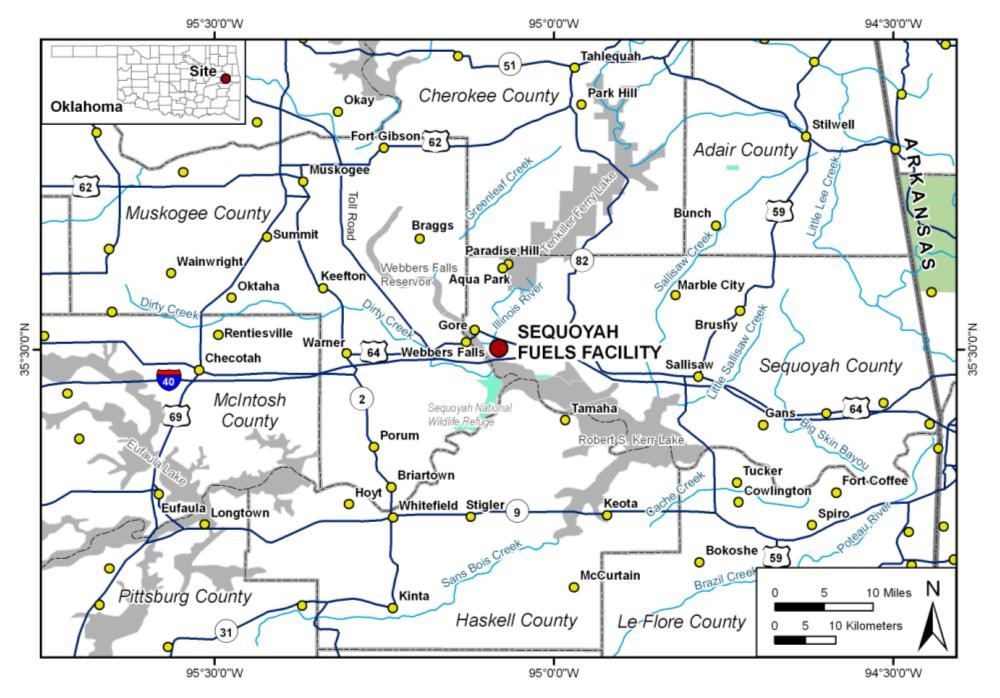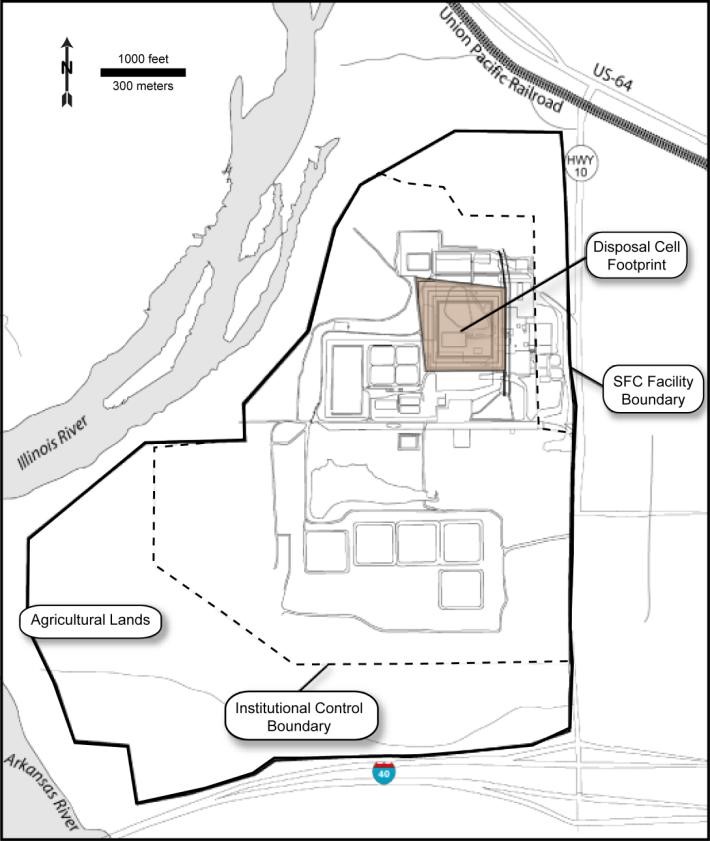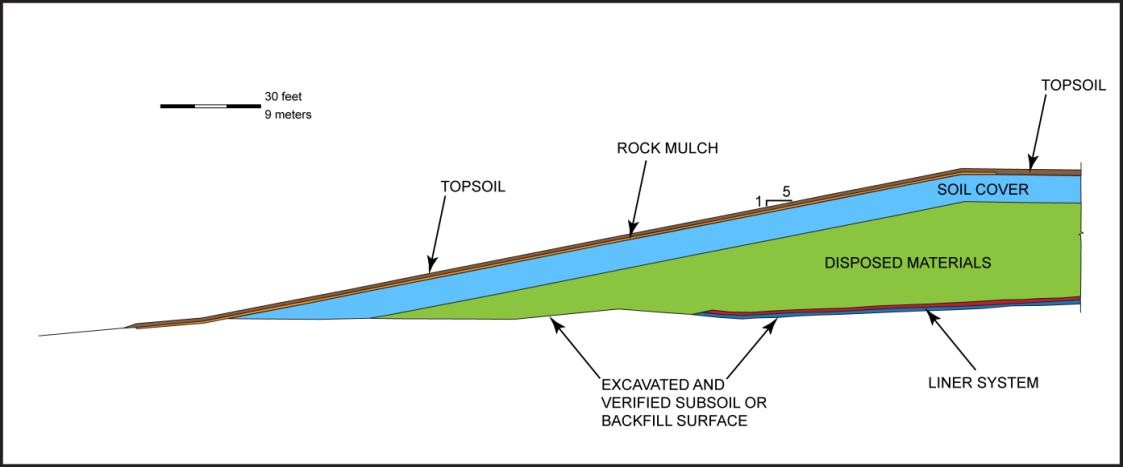Sequoyah Fuels Corporation
This page includes links to files in non-HTML format. See Plugins, Viewers, and Other Tools for more information.
Site Identification
| Type of Site: | Uranium Recovery Facility |
|---|---|
| Location: | Gore, OK |
| License No.: | SUB-1010 |
| Docket No.: | 04008027 |
| License Status: | Possession Only License |
| Project Manager: | Douglas Mandeville |
Site Status Summary
The 600 acre site is located in mideastern Oklahoma about 150 miles east of Oklahoma City, Oklahoma; 40 miles west of Fort Smith, Arkansas; 25 miles south east of Muskogee, Oklahoma; and 2.5 miles southeast of Gore, Oklahoma (Figure 1). The facility is situated above the east bank of the Illinois River at its confluence with the Arkansas River.
 |
|
Figure 1: Sequoyah Fuels Facility Site Location Map |
Under Materials License SUB-1010, the Sequoyah Fuels Corporation (SFC) operated a uranium conversion facility providing purification and conversion of yellowcake to UF6 for private nuclear utilities from 1970 to 1992. SFC ceased operating the facility in 1993. Uranium and thorium contamination of the soils and subsoils has been identified at the site. In addition, the groundwater is contaminated with uranium, thorium and metals.
The SFC site (within the institutional control boundary; Figure 2) includes an 85-acre Process Area where high-purity uranium hexafluoride (UF6) was produced from yellowcake; the remaining portion was used to manage storm water and store byproduct materials. Most of the land outside of the institutional control boundary is used either for grazing cattle or producing forage. In addition to the main processing facilities, the site also included (i) a yellowcake storage area, (ii) a yellowcake sampling facility, (iii) a bulk chemicals storage area, (iv)a fluorine production facility, (v) treatment systems and storage ponds for liquid effluent streams, and (vi) an ammonium nitrate recovery facility. Other facilities within the site included a yellowcake drum storage area, electrical substation, UF6 cylinder storage area, tank farm for liquid chemicals and fuel oil, cooling tower, sanitary sewage facilities, retention ponds for sludge and fertilizer processing, and an emergency water supply reservoir.
 |
|
Figure 2: Sequoyah Fuels Facility Site Layout |
The site is on gently rolling to level land with several steep slopes to the northwest and wooded lands to the north and south. Slopes over most of the upland areas of the site are less than 7 percent. Steeper slopes in creek ravines and on hillsides average roughly 28 percent. Slopes are very steep near the Robert S. Kerr Reservoir southeast of the site. Site hydrogeologic units are classified into four regimes: terrace, alluvial, shallow, and deep bedrock groundwater systems. The terrace groundwater system is the uppermost regime and contains the terrace deposits and the Unit 1 Shale. Depth to groundwater varies from 8 to 11 feet; however, a few unsaturated zones exist in this system near the Solvent Extraction Building, Pond 2 area, and southwest and west of the Fluoride Holding Basin No. 2. Groundwater appears to flow radially northwest to southwest from the area beneath the Main Processing Building. Recharge to this system occurs as infiltrating precipitation. However, artificial recharge from leaks in the fire suppression system and unlined ponds has occurred in the past. Groundwater underlying the onsite disposal cell area has been contaminated.
SFC submitted decommissioning plans in 1998 and 1999. However, the key to decommissioning the site was the NRC's July 2002 determination that most of the waste material at the site can be classified as byproduct material defined in Section 11e. (2) of the Atomic Energy Act of 1954, as amended. The license was amended to allow possession of byproduct material. Requirements of significance to SFC are that sites with this material must be remediated in accordance with Appendix a of 10 CFR Part 40 and that sites with byproduct material above specified concentrations must be transferred to a government custodian for perpetual care. In the absence of a government custodian DOE must accept the site and become the custodian. To comply, SFC submitted a reclamation plan to the NRC on March 15, 2003 and the plan was approved in April 2009. Under this plan DOE would become the custodian. Other important documents included the 2003 submittal of a groundwater monitoring plan (approved in 2005) and a June 2003 submittal of a groundwater corrective action plan (approved in 2010).
Site decommissioning and reclamation included dismantlement and removal of systems and equipment, demolition of structures, removal and treatment of sludges and sediments, remediation of contaminated soils, and treatment of wastewater. In November 2009, SFC began construction of the 8.3-million-cubic-foot onsite disposal cell in which most of the residual waste material was placed for permanent disposal (Figures 2 and 3). Raffinate material was also to be placed in the cell but injunctions filed by the State of Oklahoma and the Cherokee Nation prevented this and by December 5, 2018, the last of 12,644 bags containing a total of 10, 972 tons of raffinate material was shipped to the Energy Fuels White Mesa Mill in Utah.
 |
|
Figure 3: Schematic Cross Section of the Onsite Disposal Cell |
Throughout this process the NRC conducted in-process inspections of site decommissioning activities such as remediation of impacted soil, cell construction, material emplacement, and selection of cover material for the cell.
SFC anticipates submitting an Alternate Concentration Limit (ACL) application to the NRC in calendar year 2024.
Major Technical or Regulatory Issues
There is significant groundwater contamination at this site which the groundwater monitoring and corrective action plan are intended to address. A hearing was granted to the State of Oklahoma and the Cherokee Nation on issues related to the reclamation plan proposed by SFC. Additionally, Oklahoma appealed, to the Tenth Circuit Court of Appeals, the Commission's decision regarding classification of some wastes as 11e.(2) byproduct material. Oklahoma also petitioned for a hearing on SFC's proposed plan to dewater raffinate sludges that were in settlement ponds. Negotiations between Oklahoma, the Cherokee Nation, and SFC were successful in resolving issues. As a result, the lawsuit was withdrawn and the hearings have been terminated.
Estimated Date for Closure
2025
Page Last Reviewed/Updated Wednesday, September 06, 2023
Page Last Reviewed/Updated Wednesday, September 06, 2023

